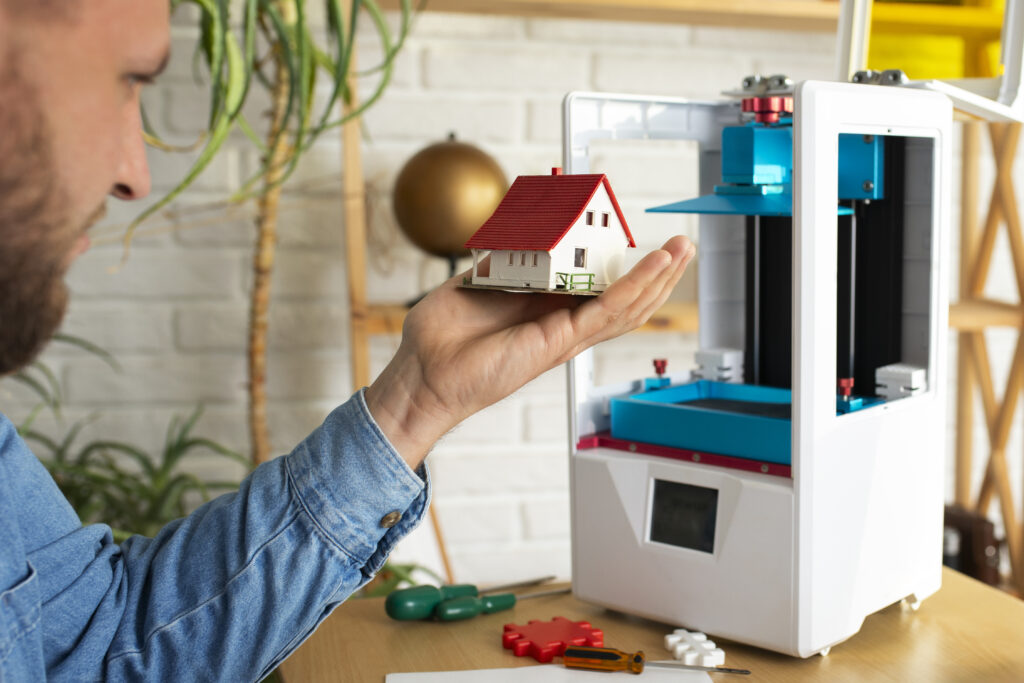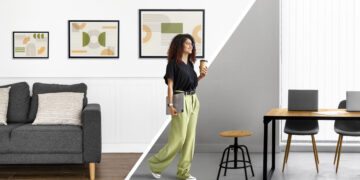A small home doesn’t have to feel cramped or cluttered. With a few design choices and smart systems, you can open up sightlines, add storage, and layer warmth without sacrificing personality. The ideas below come from a mix of interior design practice and evidence-backed principles—how light behaves, how color affects perception, how people move through rooms. The goal is simple: make your space work harder and feel calmer, using approachable home hacks decoradtech.
Start with flow
Before buying anything new, look at how you move through the room. Aim for one clear path from door to window and avoid placing bulky pieces where your body naturally wants to walk. Designers often keep at least 30–36 inches for main walkways and 18 inches for secondary paths. Furniture with visible legs helps air and light pass under pieces, which tricks the eye into reading more floor area. Note door swings, radiator lines, outlet locations, and window heights. A few minutes of measuring saves hours of frustration and prevents expensive returns.
Make light the luxury
Bright, even lighting is the fastest way to make a small room feel generous. Let in as much daylight as you can with sheers and rods mounted a few inches above the window frame to lengthen the wall. At night, layer three types of light: ambient (ceiling or floor lamps), task (desk or reading lamps), and accent (picture lights, strip LEDs). Dimmers are your best friend—they add mood control without new fixtures. A mirror placed opposite or diagonal from a window bounces light deeper into the room; angle it to avoid glare. For color temperature, warm-white (2700–3000K) keeps small rooms cozy, while neutral-white (3500–4000K) can make kitchens and work nooks feel crisp and clean.
Color that expands
Color shapes how we perceive space. Low-contrast palettes—walls, trim, and larger furniture within a tight tonal range—visually quiet a room, so your eye doesn’t stop at every edge. If your walls are light, carry a similar tone onto the ceiling, just a shade lighter, to stretch height. In very tiny rooms, “color drenching” (walls, trim, sometimes doors in one hue) can remove visual breaks and feel surprisingly expansive. Keep one grounded accent tone through textiles or a single cabinet to avoid a washed-out look. Choose medium-scale patterns for pillows or rugs; in small spaces, tiny prints get busy and oversized motifs can overwhelm.
Texture with restraint
Texture gives warmth without crowding. Pick one hero texture—bouclé, linen, rattan, velvet—and let two supporting textures play backup. This keeps depth without noise. If you add shine (metal, glass), balance it with matte surfaces so reflections don’t feel chaotic. A chunky knit throw, a smooth leather tray, and lightly grained wood can all live together if the palette is cohesive.
Build up, not out
Vertical storage is a small-space secret. Mount shelves higher than you think—12 to 16 inches from the ceiling—so you preserve more mid-level wall for art and light. Over-door shelves and above-window ledges rescue dead zones. In the kitchen, risers double shelf capacity, and a magnetic knife strip frees a whole drawer. Peg rails, attractive wall hooks, and magnetic strips keep daily-use items visible but tidy. Choose clear bins and uniform labels so your brain reads one calm system rather than a dozen mismatched containers. Leave some negative space on shelves; it signals order.
Furniture that works twice
Multi-taskers stretch square footage. Storage ottomans hold throws and board games. Drop-leaf tables expand for guests and tuck small for everyday life. Nesting tables slide apart for serving and back together for floor space. Daybeds with drawers or sofa beds with real mattresses turn a living room into a guest room. Consider a Murphy desk or a fold-down console for work-from-home days. A few sizing cues help: a coffee table that’s roughly half the sofa width, with 14–18 inches of legroom; dining chairs that tuck in cleanly so you don’t snag the walkway.
Define micro-zones
One room can do many jobs if each task has a visual cue. Use a rug to anchor the living area, a pendant to mark the dining spot, and a slim open shelf to hint at separation without blocking light. Ceiling-mounted curtains can create a flexible guest zone in a studio; draw them when needed, open them when not. Add soft textiles—rugs, curtains, acoustic panels—to absorb echo and lower stress. Small spaces feel calmer when sound is gentle.
Choose big, not busy
Counterintuitive but true: fewer, larger decor elements often read cleaner than many small ones. A single oversized art piece simplifies a wall. One large plant draws the eye up. A sizable table lamp can act like sculpture and light in one. Keep wall art centerlines around 57–60 inches for a natural sightline. Swapping hardware on cabinets and dressers—solid metal pulls, classic knobs—instantly elevates basic pieces without new furniture.

Add smart decor
This is where home hacks decoradtech shines. Smart bulbs let you program morning brightness and evening warmth, creating rhythm and comfort. Compact smart speakers or display frames can blend into shelves as decor rather than gadgets. Cable management—adhesive raceways, sleeves, and behind-leg clips—keeps tech from visually cluttering corners. Use slim multi-outlet cubes or under-desk mounts to remove floor tangle. A motion-activated night light along a baseboard is practical and almost invisible.
Entry wins
An organized entry sets the tone. A narrow shoe cabinet or bench with hidden storage manages the daily pile. A small tray and key dish save minutes every morning. A row of sturdy wall hooks handles coats and bags more flexibly than a cramped closet. A mirror near the door offers a quick check and bounces light back into the room. If there’s no closet, consider a ceiling-mounted rod with a curtain to conceal seasonal items.
Living room lifts
Raise curtain rods, choose a leggy sofa, and use nesting side tables to keep floor lines visible. Layer light with a floor lamp behind the sofa and a table lamp near reading chairs. One large piece of art or a clean gallery of three can anchor the room. Keep throw pillows to a simple palette so the seating looks calm. If the TV dominates, mount it and run a paint-matched cable channel so the wall stays clean.
Kitchen clarity
Vertical thinking pays off here. A wall-mounted rail or pegboard keeps utensils, pans, and mugs within reach. Magnetic strips hold knives and small spice tins. Inside cabinets, use shelf risers, turntables, and clear bins to prevent back-of-cabinet loss. Decanting dry goods into uniform containers isn’t just pretty; it improves visibility and reduces repurchasing what you already own. Under-cabinet battery lights brighten prep zones without rewiring. Keep counters as clear as possible; it signals space and makes cooking less chaotic.
Bedroom calm
Ground the bed with an appropriately sized rug or two runners on either side if space is tight. Floating nightstands keep floors clear and offer just enough surface for essentials. Wall sconces or mounted reading lamps free nightstand space and create a hotel-like feel. Under-bed drawers or zippered fabric bins store off-season clothing; add cedar blocks for freshness. Layer sheers with soft blackout curtains so you choose privacy and light, not one or the other. Keep the palette restrained—bedrooms benefit from fewer contrast points.
Bathroom order
Small baths need vertical solutions. Over-toilet shelving adds a whole cabinet’s worth of storage. A slim rolling cart slips between sink and wall to corral everyday items. Hooks beat towel bars in very small rooms because they handle multiple towels without precise folding. Refillable bottles clear label clutter and look cohesive. A fog-resistant mirror and warm LED bulbs flatter skin tones and make mornings brighter.
Renter-friendly moves
You can do a lot without opening walls. Removable wallpaper or decals add pattern to one feature wall. Peel-and-stick tiles upgrade backsplashes and even some floors without damaging the substrate. Command hooks and picture hanging strips carry surprising weight if you follow directions. If you buy secondhand, measure twice, inspect frames and joinery, and remember you can swap hardware and add new legs to transform a piece. Paint, new textiles, and updated lighting offer the biggest visual change for the lowest cost.
Tidy systems that stick
Clutter returns unless you build habits. Try a “one-in, one-out” rule for categories like mugs, tees, and throw pillows. Do a 10-minute evening reset—dishes, surfaces, and a quick basket sweep to put wayward items back in their homes. Mark your calendar for a seasonal mini-edit. Focus on containers that fit the space you have; too much storage invites keeping too much stuff.
A quick makeover story
Picture a 420-square-foot studio with a single window and a tangle of cords on the floor. The path from the door to the bed cut straight through the living area. We pulled the sofa off the wall by a few inches, centered it on the window, and swapped a skirted couch for a leggy loveseat. A drop-leaf table tucked behind the sofa became a dining spot with two stools that slide underneath. We mounted a mirror diagonal to the window and added a tall plant by the darkest corner to draw the eye up. Shelves went high, with clear bins and uniform labels; a peg rail handled bags and hats. Smart bulbs shifted from bright white for work to warm light for evenings, and adhesive raceways tamed cables. Floor space looked larger, the walking path felt natural, and the owner gained an extra seating zone without adding square footage.
Quick checklist
- Raise curtain rods and hang sheers to boost light and height.
- Layer ambient, task, and accent lighting; add dimmers.
- Choose a low-contrast palette; lighten the ceiling slightly.
- Pick one hero texture and two supporting textures.
- Mount shelves high; use over-door and above-window storage.
- Add peg rails, hooks, and magnetic strips for daily items.
- Choose multi-functional furniture with closed storage.
- Define zones with rugs, pendants, and open shelving.
- Favor fewer, larger decor statements over many small ones.
- Hide cords with raceways and under-desk mounts.
- Use renter-safe upgrades like peel-and-stick and hardware swaps.
- Build daily reset habits and seasonal edits.
FAQs
How do I make a tiny room feel bigger without repainting?
Increase light and reduce contrast. Swap heavy curtains for sheers, add a floor lamp, and use a large mirror opposite a window. Remove one small piece of furniture and tidy cords to open sightlines.
Are dark colors ever okay in small spaces?
Yes. A deep, saturated hue on all walls and trim can remove visual breaks and feel cocooning, especially with warm layered lighting and lighter floors or textiles for balance.
What size sofa works best in a small living room?
Look for a two-seat or apartment-size sofa with visible legs. Aim for depths around 34–36 inches and lengths that leave at least 30 inches of walkway. Consider a chaise only if it won’t block circulation.
How many decor items belong on a shelf?
Group items in odd numbers and vary height, but leave negative space. A practical rule: fill about two-thirds of a shelf and leave one-third clear, especially at eye level.
Closing thoughts
Style doesn’t come from square footage; it grows from thoughtful decisions repeated across a room. Start with one lighting upgrade and one storage fix this week. The compounding effect of small changes is real. Stay patient, edit often, and let your home tell your story—clearly, lightly, and with the kind of ease that makes small space living feel big.
Sources and design notes
- Building and staging practices emphasize clear pathways and visual continuity for perceived spaciousness.
- Lighting design principles support layered lighting and appropriate color temperature for task and mood.
- Color and perception research and long-standing interior practice favor low-contrast schemes and consistent tonal palettes to quiet small rooms.
- Ergonomic spacing guidelines commonly used by interior designers inform walkway widths and furniture sizing.
- Organization methods highlighting vertical storage, uniform containers, and clear labels improve findability and reduce visual noise.
These practices align with what many residential designers, builders, and professional organizers teach in the field. Applied with care—and a bit of your own taste—they turn home hacks decoradtech into an everyday tool for calmer, smarter living.





















































